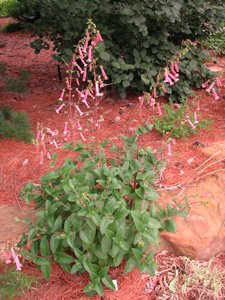Resource Library
Plant of the Week: Fuchsia, Cape
The University of Arkansas System Division of Agriculture does not promote, support or recommend plants featured in "Plant of the Week." Please consult your local Extension office for plants suitable for your region.
Plant of the Week
Cape Fuchsia
Latin: Phygelius x rectus

Every time I see my local hummingbirds buzz by the front window I feel guilty for not providing more summertime flowers. Being too lazy to put up sugar water feeders, my poor hummers must fend for themselves. Maybe next spring I’ll get around to planting come cape fuchsia (Phygelius x rectus) hybrids and make their summertime work a bit easier.
Cape fuchsia is a member of the snapdragon family with the two described species native to South Africa. In their native frost-free region they are evergreen subshrubs, but most gardeners know them as herbaceous perennials that freeze to the ground each winter. Leaves are deep green, oblong and borne in opposite pairs.
P. capensis grows in the coastal region and was the first to be collected and grown by Europeans. It bears its flowers in an open panicle that can grow to 4 feet tall with the dangling, tubular blooms borne around the floral stem. P. aequalis is slightly shorter and occurs more inland at higher elevations. It holds its tubular flowers along one side of the flower stem. Most of the plants seen in the nursery trade today are hybrids of these two species with flower colors ranging from yellow to the more common shades of orange or red.
I’ve grown cape fuchsias on and off for 40 years, but for me in my zone 6b/7a garden they usually persist a year or two and then disappear over winter. They have been available during this period, but mostly only from mail order nurseries, and even then, have never been commonly seen. They seem to have been grown since at least the middle of the 19th century but never really caught on in the United States. But, as with all things green, that could change as breeders – led by Englishman David Kerley and his CandyDrop series – introduce a new range of colors and forms into the plant supply chain.
The Latin name for the genus translates as “sun flight,” an indication that the plants prefer to hide from the sun. However the cape fuchsias should not be thought of as shade plants; instead they like a bright location with lots of light but protection from the hot afternoon sun.
They are best in a rich, well-drained and uniformly moist soil. Cape fuchsias flower from spring to fall in the South but July and August are a challenge to them and, unless kept relatively moist and well fertilized, will stop growing and flowering during the heat. While they are considered hardy from zones 7 through 9, cape fuchsia is best considered a short lived perennial or even annual. It works well in the mixed border or fits in well in containers.
By: Gerald Klingaman, retired
Retired Extension Horticulturist - Ornamentals
Extension News - August 24, 2012
The University of Arkansas System Division of Agriculture does not maintain lists of retail outlets where these plants can be purchased. Please check your local nursery or other retail outlets to ask about the availability of these plants for your growing area.